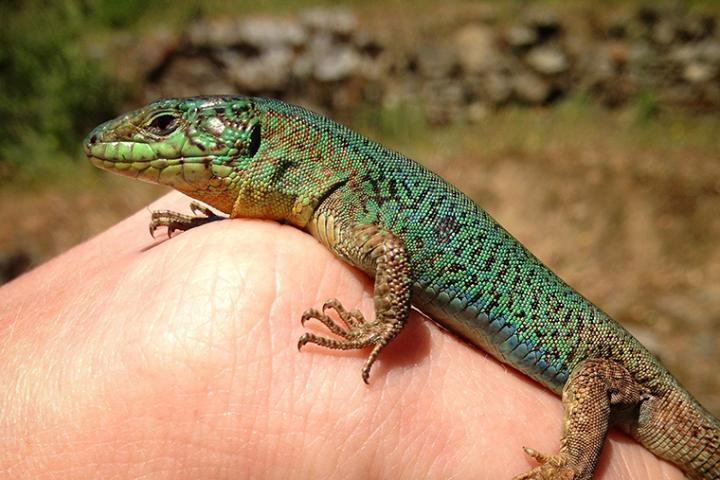Animal chemical signals shift after only four generations

Credit: Colin Donihue
Relocated in small groups to experimental islands, lizards rapidly and repeatedly developed new chemical signals for communicating with each other. Free from the risk of predators and intent to attract potential mates, male lizards produce a novel chemical calling card, according to new research from Washington University in St. Louis.
Studies of animal signal evolution usually focus on acoustic and visual signals — like the complex warbling in a bird’s song or the bright flashes of color on fish scales. Chemical signals between animals are less obvious to humans and more technically complex to parse. Much of the existing research on these signals has focused on insect pheromones relevant to certain agricultural applications.
But chemical signals are the oldest and most widespread communication mode, spanning bacteria to beavers. As such, they represent a valuable opportunity for decoding how animals communicate and perceive the world around them, researchers said.
“What we’ve discovered is that within species there is important variation in chemical signals depending on your context: Who’s trying to eat you, who wants to mate with you and who you’re trying to compete with,” said Colin Donihue, a postdoctoral fellow in biology in Arts & Sciences at Washington University in St. Louis and lead author of a new study published April 21 in the Journal of Animal Ecology.
Both lizards and snakes collect chemical cues from their surroundings by flicking out their slender forked tongues, then process those cues using a well-developed sensory organ in the roof of their mouths.
Lizards deposit their chemical messages encoded in secretions from specialized glands located on their inner thighs. The secretions are a waxy cocktail of lipid compounds that contains detailed information about the individual lizard that produced them.
In this study, researchers relocated groups of eight male and 12 female Aegean wall lizards (Podarcis erhardii) from a single source population in Naxos, Greece, to five small islets that lacked predators. Under normal conditions, these lizards would have to contend with a number of native and non-native predators — including snakes, birds and cats.
Free from predators on the small islets, the lizard populations grew rapidly and competition for resources was fierce.
Each of the relocated lizards was individually tagged so they could be identified when the researchers returned to check up on them. Over the next four years, the scientists revisited the populations, tracking the fates of the relocated lizards and their offspring.
What they found was striking: On each of the predator-free islands, lizards rapidly and repeatedly developed a new chemical “mix” that was distinct from that of lizards in the source population. The changes were apparent after only four generations.
For the first time, researchers believe that they have demonstrated solid evidence that lizards can “put on a new cologne” to suit their setting.
“Signals to attract mates are often conspicuous to predators,” said Simon Baeckens, a postdoctoral fellow at the University of Antwerp in Belgium and co-author of the new paper. “As such, sexual signals present a compromise between attractiveness and avoidance of detection. However, on these islets, there is no constraint on the evolution of highly conspicuous and attractive signals.
“In the experimental islands, we found that the ‘signal richness’ of the lizard secretions is the highest — meaning that the number of different compounds that we could detect in the secretion is the highest,” Baeckens added. “Our previous research suggests that this more elaborate signal might advertise the high quality of a male.”
Donihue continued: “Animals have spent over a billion years developing a complex chemical communication library. But we only invented the technology to identify many of those chemicals a century ago, and the experiments for understanding what those chemicals mean for the animals in nature have only just begun.
“We found that animal chemical cues can rapidly and flexibly change to suit new settings, but this is only the beginning for understanding what the lizards are saying to each other.”
###
Media Contact
Talia Ogliore
[email protected]
Related Journal Article
http://dx.




